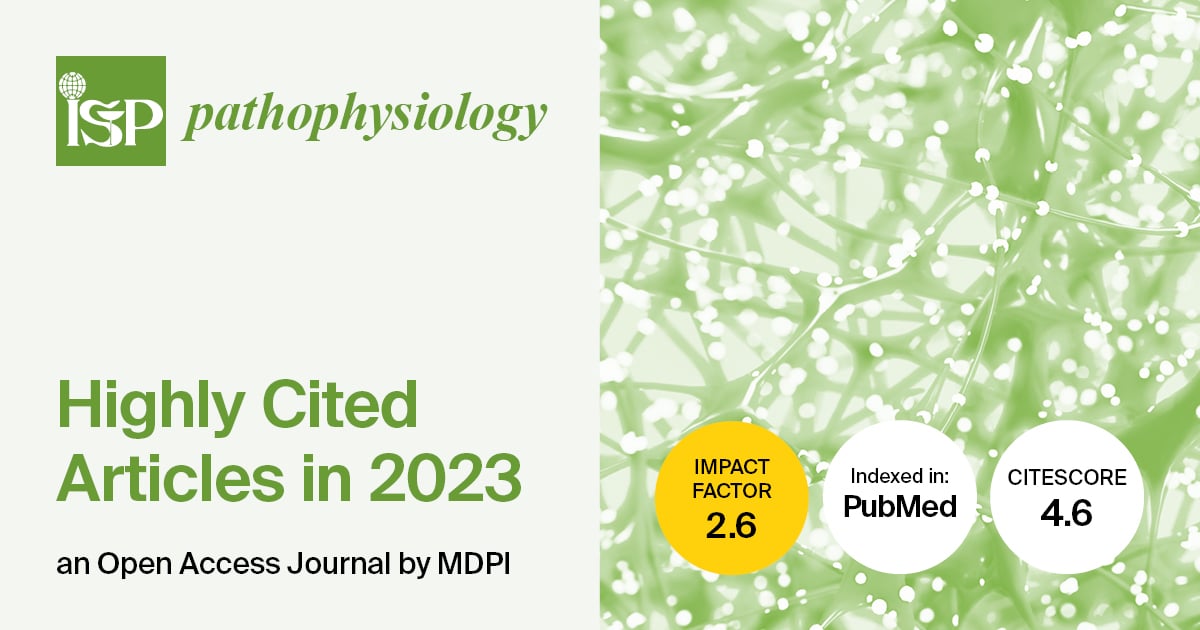Journal Description
Pathophysiology
Pathophysiology
is an international, peer-reviewed, open access journal on the etiology, development, and elimination of pathological processes. Pathophysiology is the official journal of the International Society for Pathophysiology (ISP) and is published quarterly online by MDPI (from Volume 27, Issue 1 - 2020).
- Open Access— free for readers, with article processing charges (APC) paid by authors or their institutions.
- High Visibility: indexed within ESCI (Web of Science), Scopus, PMC, PubMed, and other databases.
- Journal Rank: JCR - Q2 (Pathology) / CiteScore - Q2 (Pathology and Forensic Medicine)
- Rapid Publication: manuscripts are peer-reviewed and a first decision is provided to authors approximately 24.7 days after submission; acceptance to publication is undertaken in 2.9 days (median values for papers published in this journal in the first half of 2025).
- Recognition of Reviewers: APC discount vouchers, optional signed peer review, and reviewer names published annually in the journal.
Impact Factor:
2.6 (2024)
Latest Articles
Post-COVID-19 Femoral Head Osteonecrosis Exhibits Mast Cell Clusters, Fibrosis, and Vascular Thrombosis: Key Pathological Mechanisms in Long COVID-19 Bone Degeneration
Pathophysiology 2025, 32(3), 36; https://doi.org/10.3390/pathophysiology32030036 - 18 Jul 2025
Abstract
Background/Objectives: Оsteonecrosis of the femoral head (ONFH) is a common condition in hip surgery, which is characterized by the death of bone cells due to disruption of the blood supply and ultimately irreversible destruction of the hip joint. As a result of the
[...] Read more.
Background/Objectives: Оsteonecrosis of the femoral head (ONFH) is a common condition in hip surgery, which is characterized by the death of bone cells due to disruption of the blood supply and ultimately irreversible destruction of the hip joint. As a result of the COVID-19 pandemic, a significant increase in the incidence of ONFH has been identified. To better understand the pathogenesis of ONFH in the context of COVID-19, our research aimed to determine pathomorphological changes in articular tissues specific to post-COVID-19 ONFH. Methods: Using morphological, morphometric, and statistical methods, the femoral heads after hip arthroplasty were retrospectively studied in patients with post-COVID-19 ONFH (n = 41) compared to a non-COVID-19 group of patients (n = 47). Results: Оur results revealed that the key morphofunctional biomarkers of post-COVID-19 ONFH were clusters of mast cells, extensive areas of fibrosis, numerous arterial and venous thrombi, and giant cell granulomas. The potential relationship of those morphological features with the action of the SARS-CoV-2 coronavirus was discussed. Conclusions: Mast cells have been proposed as the leading players that may trigger the main molecular and cellular mechanisms in the development of post-COVID-19 ONFH and can be considered a diagnostic sign of the disease.
Full article
Open AccessOpinion
Prenatal Alcohol Exposure and Congenital Heart Defects: Retinoic Acid Deficiency as a Potential Mechanism in Dextro-Type Transposition of the Great Arteries
by
Roberto Paparella, Carolina Putotto, Marco Fiore, Fiorenza Colloridi, Paolo Versacci, Mauro Ceccanti, Bruno Marino and Luigi Tarani
Pathophysiology 2025, 32(3), 35; https://doi.org/10.3390/pathophysiology32030035 - 10 Jul 2025
Abstract
Fetal alcohol spectrum disorder (FASD) is a preventable cause of developmental disabilities linked to prenatal alcohol exposure (PAE). Congenital heart defects (CHDs) are frequently observed in FASD, with a notable association between PAE and dextro-type transposition of the great arteries (d-TGA). A potential
[...] Read more.
Fetal alcohol spectrum disorder (FASD) is a preventable cause of developmental disabilities linked to prenatal alcohol exposure (PAE). Congenital heart defects (CHDs) are frequently observed in FASD, with a notable association between PAE and dextro-type transposition of the great arteries (d-TGA). A potential pathogenetic mechanism of d-TGA in FASD, involving retinoic acid (RA) deficiency due to the interference of ethanol with RA biosynthesis, is proposed. Further investigation is required to understand the timing and impact of alcohol exposure on congenital anomalies, particularly in the context of CHDs.
Full article
(This article belongs to the Section Cardiovascular Pathophysiology)
►▼
Show Figures

Figure 1
Open AccessReview
Thiamine Deficiency and Neuroinflammation Are Important Contributors to Alcohol Use Disorder
by
Nikhila Kalapatapu, Samantha G. Skinner, Emma G. D’Addezio, Srija Ponna, Enrique Cadenas and Daryl L. Davies
Pathophysiology 2025, 32(3), 34; https://doi.org/10.3390/pathophysiology32030034 - 4 Jul 2025
Abstract
Despite the growing morbidity associated with alcohol use disorder (AUD), current FDA-approved therapeutics fail to adequately address the condition. This is in part due to the complex systemic effects of ethanol (EtOH), which have particularly negative consequences on the gut–liver–brain axis. Importantly, two
[...] Read more.
Despite the growing morbidity associated with alcohol use disorder (AUD), current FDA-approved therapeutics fail to adequately address the condition. This is in part due to the complex systemic effects of ethanol (EtOH), which have particularly negative consequences on the gut–liver–brain axis. Importantly, two systemic mechanisms underlying the progression of AUD remain underemphasized in therapeutic development: thiamine deficiency and neuroinflammation. Alcohol-induced thiamine deficiency leads to reduced activity of key metabolic enzymes, thereby resulting in energy deficits, oxidative stress, and severe clinical implications. EtOH also activates TLR4 and NLRP3, both of which play critical roles in the regulation of neuroimmune responses. While research directly investigating the relationship between thiamine deficiency and neuroinflammation is still in its early stages, our review highlights the emerging connections between these two seemingly distinct pathomechanisms. Additionally, potential therapeutic approaches and targets for addressing AUD at a systemic level are discussed.
Full article
(This article belongs to the Section Systemic Pathophysiology)
►▼
Show Figures
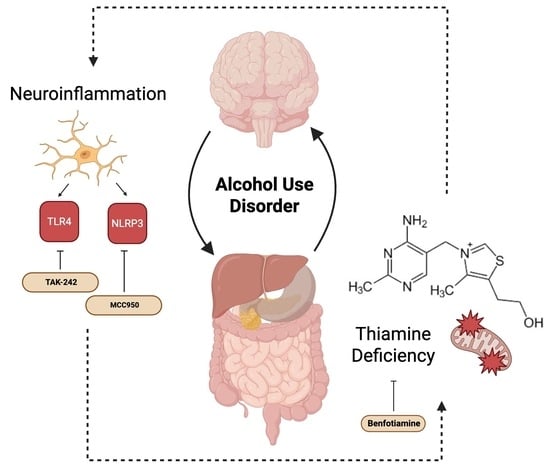
Graphical abstract
Open AccessFeature PaperReview
Understanding Renal Tubular Function: Key Mechanisms, Clinical Relevance, and Comprehensive Urine Assessment
by
Mario Alamilla-Sanchez, Miguel Angel Alcalá Salgado, Victor Manuel Ulloa Galván, Valeria Yanez Salguero, Martín Benjamin Yamá Estrella, Enrique Fleuvier Morales López, Nicte Alaide Ramos García, Martín Omar Carbajal Zárate, Jorge David Salazar Hurtado, Daniel Alberto Delgado Pineda, Leticia López González and Julio Manuel Flores Garnica
Pathophysiology 2025, 32(3), 33; https://doi.org/10.3390/pathophysiology32030033 - 3 Jul 2025
Abstract
►▼
Show Figures
Renal function refers to the combined actions of the glomerulus and tubular system to achieve homeostasis in bodily fluids. While the glomerulus is essential in the first step of urine formation through a coordinated filtration mechanism, the tubular system carries out active mechanisms
[...] Read more.
Renal function refers to the combined actions of the glomerulus and tubular system to achieve homeostasis in bodily fluids. While the glomerulus is essential in the first step of urine formation through a coordinated filtration mechanism, the tubular system carries out active mechanisms of secretion and reabsorption of solutes and proteins using specific transporters in the epithelial cells. The assessment of renal function usually focuses on glomerular function, so the tubular function is often underestimated as a fundamental part of daily clinical practice. Therefore, it is essential to properly understand the tubular physiological mechanisms and their clinical association with prevalent human pathologies. This review discusses the primary solutes handled by the kidneys, including glucose, amino acids, sodium, potassium, calcium, phosphate, citrate, magnesium and uric acid. Additionally, it emphasizes the significance of physicochemical characteristics of urine, such as pH and osmolarity. The use of a concise methodology for the comprehensive assessment of urine should be strengthened in the basic training of nephrologists when dealing with problems such as water and electrolyte balance disorders, acid-base disorders, and harmful effects of commonly used drugs such as chemotherapy, antibiotics, or diuretics to avoid isolated replacement of the solute without carrying out comprehensive approaches, which can lead to potentially severe complications.
Full article
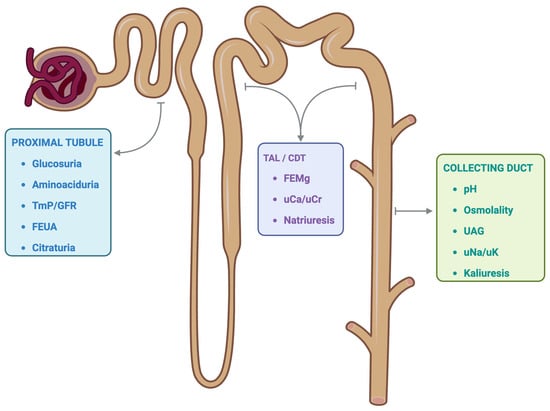
Figure 1
Open AccessArticle
Crack Cocaine Smoke Induces Tissue Degeneration in Rat Submandibular Glands by Toll-like Signaling Pathway
by
Lorrany da Silva Avanci, Daniel Vitor de Souza, Gabriel Carvalhal de Aguiar, Thiago Guedes Pinto, Barbara dos Anjos Rosario, Milena de Barros Viana, Yasmin Alaby Martins Ferreira, Viviane Carlin Cordaro, Luciana Pellegrini Pisani and Daniel Araki Ribeiro
Pathophysiology 2025, 32(3), 32; https://doi.org/10.3390/pathophysiology32030032 - 2 Jul 2025
Abstract
►▼
Show Figures
Background: This study investigated the impact of crack cocaine smoke exposure on the submandibular salivary gland of Wistar rats. Methods: The animals were distributed into four groups: control (CTRL); 25 mg exposure (CK25); 50 mg exposure (CK50); and 100 mg exposure (CK100). The
[...] Read more.
Background: This study investigated the impact of crack cocaine smoke exposure on the submandibular salivary gland of Wistar rats. Methods: The animals were distributed into four groups: control (CTRL); 25 mg exposure (CK25); 50 mg exposure (CK50); and 100 mg exposure (CK100). The animals were exposed to crack cocaine smoke once a day for five consecutive days. Results: Exposure to crack cocaine smoke-induced histopathological changes in submandibular salivary glands in all groups under exposure. The immunohistochemical analysis demonstrates that exposure to crack cocaine smoke led to an increase in BCL-2 and P16 expression in all groups exposed to crack cocaine (p < 0.05). The analysis of Ki-67 expression revealed a significant increase in immunoreactive cells across all exposure groups (p < 0.05). Although MYD88 expression was observed in all crack cocaine-exposed groups, only the group treated with the highest dose (100 mg) exhibited a statistically significant increase compared to the control group (p < 0.05). Conclusions: In summary, this study demonstrates that exposure to crack cocaine smoke-induced tissue degeneration in the submandibular salivary gland, increasing cellular senescence and promoting compensatory cell proliferation in Wistar rats.
Full article
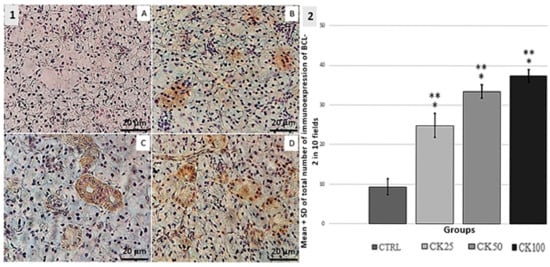
Figure 1
Open AccessCase Report
A Rare Case of Cerebral Amyloidoma Mimicking Thalamic Glioma in a Rheumatoid Arthritis Patient
by
Elyaa Saleh, Nour Abdelaziz, Malaak Ramahi, Antonia Loukousia, Theodossios Birbilis and Dimitrios Kanakis
Pathophysiology 2025, 32(3), 31; https://doi.org/10.3390/pathophysiology32030031 - 1 Jul 2025
Abstract
Amyloidosis, often referred to as “the great imitator”, is a condition characterized by the abnormal deposition of amyloid proteins in various tissues, potentially leading to organ dysfunction. When these deposits localize in the brain, they can disrupt neurological function and present with diverse
[...] Read more.
Amyloidosis, often referred to as “the great imitator”, is a condition characterized by the abnormal deposition of amyloid proteins in various tissues, potentially leading to organ dysfunction. When these deposits localize in the brain, they can disrupt neurological function and present with diverse clinical manifestations, making diagnosis particularly challenging. Cerebral amyloidosis is a rare entity that frequently mimics other neurological disorders, often resulting in significant delays in recognition and management. This case highlights the diagnostic challenge posed by cerebral amyloidosis and underscores its unique presentation. We present the case of a 76-year-old male with a history of rheumatoid arthritis (RA) who developed progressive right-sided weakness over several months. Three years prior, he experienced numbness on the right side of his face and upper limb. Initial imaging identified a small lesion in the left thalamic region, which was originally diagnosed as a glioma. However, due to the worsening of his clinical symptoms, further evaluation was warranted. Subsequent imaging revealed lesion growth, prompting a biopsy that ultimately confirmed the diagnosis of intracerebral amyloidoma. This case underscores the necessity of considering amyloidosis in the differential diagnosis of atypical neurological deficits, particularly in patients with systemic inflammatory conditions such as RA. The initial presentation of hemiparesis resembling a stroke, coupled with non-specific imaging findings and a prior misdiagnosis of glioma, highlights the complexity of cerebral amyloidosis. Only through brain biopsy was the definitive diagnosis established, emphasizing the need for improved diagnostic modalities to facilitate early detection. Further subtyping of amyloidosis, however, requires mass spectrometry-based proteomics or immunohistochemistry to accurately identify the specific amyloid protein involved. Clinicians should maintain a high index of suspicion for cerebral amyloidosis in patients with RA who present with progressive neurological deficits and atypical brain lesions. Early recognition and accurate diagnosis are essential to guiding appropriate management and improving patient outcomes.
Full article
(This article belongs to the Section Systemic Pathophysiology)
►▼
Show Figures
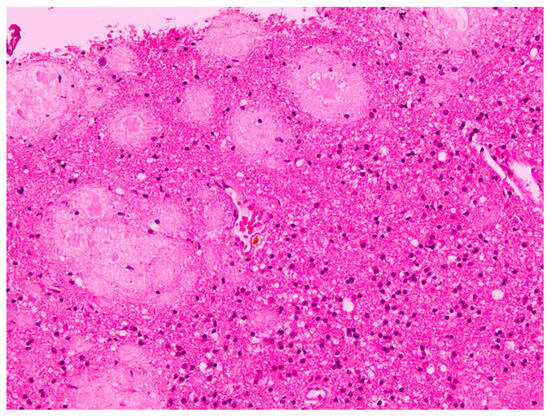
Figure 1
Open AccessArticle
C4d Immunoreactivity in Autoimmune and HBV-Induced Hepatitis: Implications for Complement-Mediated Hepatocellular Injury
by
Ye Zheng, Haitao Tong, Wenjuan Guo, Ao Wang, Wenxing Hu, Min Wu and Xiaonan Zhang
Pathophysiology 2025, 32(3), 30; https://doi.org/10.3390/pathophysiology32030030 - 1 Jul 2025
Abstract
Background: Although immune complex formation is widely acknowledged as the etiological agent for the development of systemic lupus erythematosus, polyarteritis nodosa, reactive arthritis, etc., its roles in chronic hepatitis are less understood. This study aims to compare the immunohistochemistry profile of immune complex
[...] Read more.
Background: Although immune complex formation is widely acknowledged as the etiological agent for the development of systemic lupus erythematosus, polyarteritis nodosa, reactive arthritis, etc., its roles in chronic hepatitis are less understood. This study aims to compare the immunohistochemistry profile of immune complex deposition in patients with chronic hepatitis B (CHB) and autoimmune hepatitis (AIH). Methods: Immunohistochemistry of C4d, a widely used marker for complement deposition was employed on liver biopsies from 72 and 15 patients with CHB and AIH, respectively. Statistical analysis was performed to analyze its prevalence and its association with a range of clinical and histological parameters. Results: Among the 15 AIH biopsies examined, C4d deposition was observed in 11 cases (73.3%), the majority of which showed a periportal staining pattern (10/11). In CHB, 61 (84.7%) of 72 cases tested positive for C4d, which did not differ significantly with that of AIH. While the periportal pattern was predominantly observed in CHB cases, positive staining in central veins, sinusoids, and hepatic parenchyma were also documented. In particular, C4d deposition is significantly associated with elevated serum ALT and liver inflammation in CHB. Of note, in specimens with a patchy parenchymal C4d staining pattern, a spatially correlated HBsAg IHC signal was observed in adjacent sections from the same tissue. Conclusions: These data suggest an involvement of immune complex-mediated immunopathy in autoimmune hepatitis and HBV-induced hepatitis. The positive intrahepatic C4d signal was associated with heightened liver inflammation. The colocalization of the C4d signal on hepatocytes with HBsAg strongly suggests a causal relationship between viral activity and complement deposition. These observations align with our recent evidence implicating the contribution of capsid–antibody complexes in the pathogenesis of CHB.
Full article
(This article belongs to the Section Systemic Pathophysiology)
►▼
Show Figures
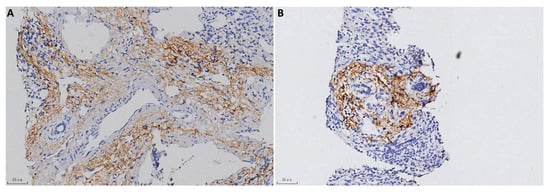
Figure 1
Open AccessArticle
Diabetic Ketoacidosis Is Associated with Lower Serum Sphingolipids but Higher β-Hydroxybutyrate and Lactate: A Pilot Study
by
Ibrahim Aslan, Tuğçe Çeker, Tayfun Ustabaş, Vuslat Zorlu, Çağatay Yılmaz and Mutay Aslan
Pathophysiology 2025, 32(3), 29; https://doi.org/10.3390/pathophysiology32030029 - 26 Jun 2025
Abstract
Background/Objectives: Diabetic ketoacidosis (DKA) is an acute and severe complication of diabetes mellitus, marked by hyperglycemia, ketosis, and acidosis. It is associated with significant metabolic and inflammatory adjustments that can impact multiple biochemical pathways. This study aimed to determine the serum sphingolipid
[...] Read more.
Background/Objectives: Diabetic ketoacidosis (DKA) is an acute and severe complication of diabetes mellitus, marked by hyperglycemia, ketosis, and acidosis. It is associated with significant metabolic and inflammatory adjustments that can impact multiple biochemical pathways. This study aimed to determine the serum sphingolipid profile in DKA and investigate its relationship with neutral sphingomyelinase (N-SMase), pro-inflammatory cytokines, β-hydroxybutyrate (β-OHB), and lactate levels. Methods: Thirty-three participants were divided into three groups: control (BMI ≤ 30, no health issues), obese (BMI > 30), and DKA (BMI ≤ 30). Sphingomyelins (16:0–24:0 SMs) and ceramides (C16–C24 CERs) were measured using ultra-fast liquid chromatography combined with tandem mass spectrometry (LC-MS/MS). N-SMase, interleukin 1 beta (IL-1β), and tumor necrosis factor alpha (TNF-α) levels were assessed by enzyme-linked immunosorbent assay. Evaluations were done in the DKA group before and after standard clinical treatment for DKA (post-DKA group), which included intravenous insulin therapy, fluid resuscitation, and electrolyte replacement, as per established clinical guidelines. Results: β-OHB levels were significantly higher in the DKA group than in the control, obese, and post-DKA groups. Although β-OHB levels decreased in the post-DKA group, they remained elevated compared to the control and obese groups. Lactate levels were also higher in the DKA group, with a significant decrease in the post-DKA group. TNF-α and IL-1β were higher in the obese group compared to control and DKA groups, and TNF-α decreased significantly in the post-DKA group compared to DKA. N-SMase, 16:0–18:0 SMs, and C18-C24 CER levels were lower in the DKA and post-DKA groups compared to obese and control groups. Serum β-OHB and lactate levels were significantly correlated with S1P, total CER, total SM, and N-SMase values. Conclusions: The study reveals significant metabolic and inflammatory differences in DKA and post-DKA states, suggesting a relationship between sphingolipids, N-SMase, and these alterations, which could offer insights into DKA pathophysiology and therapeutic targets.
Full article
(This article belongs to the Section Metabolic Disorders)
►▼
Show Figures

Graphical abstract
Open AccessCommunication
Reduced Shear Stress and Longer Blood Flow Time Occur in Both Severe Focal and Mild Diffuse LAD Lesions: Angiograms Alone Don’t Always Reveal Their True Impact on Blood Flow
by
Gianluca Rigatelli, Marco Zuin, Niva Mileva, Dobrin Vassilev, Giuseppe Marchese, Ervis Hiso, Andrea Bertolini and Claudio Bilato
Pathophysiology 2025, 32(2), 28; https://doi.org/10.3390/pathophysiology32020028 - 19 Jun 2025
Abstract
Background/Objectives: The similarities and differences from a rheological perspective between significant short focal and mild long coronary lesions warrant investigation to elucidate wall shear stress (WSS) angiographic discrepancies. Methods: Patients who underwent coronary computed tomography angiography (CCTA) between 1 January 2023 and
[...] Read more.
Background/Objectives: The similarities and differences from a rheological perspective between significant short focal and mild long coronary lesions warrant investigation to elucidate wall shear stress (WSS) angiographic discrepancies. Methods: Patients who underwent coronary computed tomography angiography (CCTA) between 1 January 2023 and 1 September 2024 were selected for computational fluid dynamics (CFD) analysis. The selection criteria included either a focal (≤20 mm) hemodynamically significant stenosis, defined as ≥75% lumen narrowing, or a long (30–40 mm) non-hemodynamically significant lesion showing ≤50% stenosis of the left anterior descending (LAD) artery. Patient-specific models were reconstructed from ECG-gated CCTA images. Wall shear stress (WSS, measured in Pascals) and residence time (RT) were evaluated for each patient. Results: The LAD arteries of 30 patients (mean age 54 years, 63.3% men) were evaluated: 16 with focal, hemodynamically significant coronary stenosis, while 14 with diffuse, long, non-hemodynamically significant coronary lesions. Both groups exhibited a lower mean WSS compared to the non-stenosed segment, with no significant difference in mean WSS between the two groups (p = 0.84). Conversely, both groups demonstrated a higher mean residence time (RT) compared to the non-stenosed segments (0.2 ± 0.06 vs. 0.60 ± 0.03, p < 0.001 and 0.2 ± 0.006 vs. 0.59 ± 0.02, p < 0.001, respectively), and no significant difference in mean RT (p = 0.82). Conclusions: Long, angiographically mild coronary stenoses show similar WSS and RT characteristics compared to short hemodynamically significant coronary stenosis.
Full article
(This article belongs to the Section Cardiovascular Pathophysiology)
►▼
Show Figures

Figure 1
Open AccessArticle
A Slow Hydrogen Sulfide Donor GYY-4137 Partially Improves Vascular Function in Spontaneously Hypertensive Rats Fed a High-Fat Diet
by
Basak G. Aydemir, Andrea Berenyiova, Martina Cebova, John D. Henderson, Andrej Barta and Sona Cacanyiova
Pathophysiology 2025, 32(2), 27; https://doi.org/10.3390/pathophysiology32020027 - 18 Jun 2025
Abstract
Background/Objectives: Metabolic syndrome is one of the leading causes of mortality worldwide, with high-fat diet (HFD) intake being a significant driving force. Despite long-term research, new interventions are still being sought to improve cardiovascular disorders associated with metabolic syndrome. Methods: To explore the
[...] Read more.
Background/Objectives: Metabolic syndrome is one of the leading causes of mortality worldwide, with high-fat diet (HFD) intake being a significant driving force. Despite long-term research, new interventions are still being sought to improve cardiovascular disorders associated with metabolic syndrome. Methods: To explore the therapeutic potential of a slow-releasing H2S donor, we evaluated the effects of 3 weeks of treatment with GYY-4137 on systolic blood pressure (sBP), cardiac parameters, adiposity, selected plasma markers, and the vascular function of the thoracic aortas (TAs) and mesenteric arteries (MAs) isolated from male spontaneously hypertensive rats (SHRs) fed an HFD for 8 weeks. Results: HFD administration induced cardiac remodeling, increased adiposity, and decreased adrenergic contractility in both TAs and MAs. Moreover, although high-fat intake improved TAs relaxation, it decreased aortic protein expression of endothelial NO synthase and the involvement of NO in vasoactive responses of both TAs and MAs. In addition, protein expression of inducible NOS and tumor necrosis factor alpha (TNFα) in aortas was increased, as were plasma levels of chemerin, which has been proposed as a possible link among metabolic and vascular disorders and inflammation. Treatment with GYY-4137 reduced sBP, improved relaxation of the MAs, partially restored the contractility of the TAs, generally restored NO signaling, and decreased the protein expression of the inducible NOS and TNFα, as well as plasma chemerin levels. Conclusions: A slow H2S-releasing donor could partially ameliorate the metabolic changes induced by increased fat intake during essential hypertension and trigger beneficial vasoactive effects associated with the NO signaling restoration and suppression of inflammation.
Full article
(This article belongs to the Section Cardiovascular Pathophysiology)
►▼
Show Figures
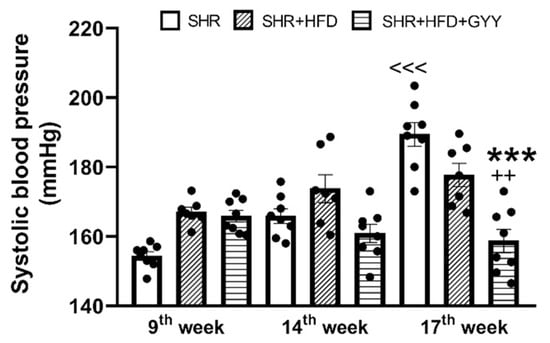
Figure 1
Open AccessReview
Linking Lipid Metabolism and Immune Function: New Insights into Chronic Respiratory Diseases
by
Stanislav Kotlyarov
Pathophysiology 2025, 32(2), 26; https://doi.org/10.3390/pathophysiology32020026 - 6 Jun 2025
Abstract
Lipids play important roles in maintaining pulmonary structure, performing physiological functions and controlling the immune status of the lung. There is increasing evidence that lipid metabolism and immune activity are closely linked and that dysfunction in lipid metabolism contributes to the development and
[...] Read more.
Lipids play important roles in maintaining pulmonary structure, performing physiological functions and controlling the immune status of the lung. There is increasing evidence that lipid metabolism and immune activity are closely linked and that dysfunction in lipid metabolism contributes to the development and progression of chronic respiratory diseases such as COPD and asthma. These diseases are characterized by metabolic and immune dysregulation, with lipid mediators playing a key role in both the development and resolution of inflammation. In this regard, lipid metabolic pathways are attracting increasing attention as promising targets for biomarker detection and therapeutic intervention.
Full article
(This article belongs to the Section Systemic Pathophysiology)
►▼
Show Figures

Figure 1
Open AccessCase Report
A Rare Case of Paired Congenital Cervical Aneurysms in a Communicating Vein: Clinical and Imaging Findings in a Pediatric Patient
by
Grigol Keshelava, Zurab Robakidze and Igor Mikadze
Pathophysiology 2025, 32(2), 25; https://doi.org/10.3390/pathophysiology32020025 - 6 Jun 2025
Abstract
►▼
Show Figures
A four-year-old female patient was admitted for evaluation after a mass on the right side of her neck was noticed during straining (Valsalva maneuver). The family first observed the mass when the patient was one year old, and noted that it gradually increased
[...] Read more.
A four-year-old female patient was admitted for evaluation after a mass on the right side of her neck was noticed during straining (Valsalva maneuver). The family first observed the mass when the patient was one year old, and noted that it gradually increased in size over time. A family history assessment revealed no known genetic disorders. The patient underwent neck ultrasonography and computed tomography angiography (CTA), which revealed two aneurysms in a right-sided communicating vein. One aneurysm was located above the jugular notch, and the other was located in the retro-parotid region. The presence of two venous aneurysms in a right-sided communicating vein—one above the jugular notch and the other in the retro-parotid region—suggests a rare and apparently benign congenital anomaly. The progressive enlargement of these malformations warrants close monitoring and surgical intervention, and long-term follow-up may be necessary to prevent complications such as thrombosis, rupture, or compression of adjacent structures.
Full article

Figure 1
Open AccessArticle
Histochemical Assessment of Reticulin–Collagen Patterns in the Mid-Secretory Endometrium Predicts Recurrent Pregnancy Loss
by
Nazerke Oshakhtiyeva, Dmitriy Klyuyev, Zhanna Amirbekova, Rinat Gatin, Anar Turmukhambetova, Kamilya Makhambetova, Irina Kadyrova and Yevgeniy Kamyshanskiy
Pathophysiology 2025, 32(2), 24; https://doi.org/10.3390/pathophysiology32020024 - 3 Jun 2025
Abstract
Background/Objectives: Normal remodeling of the extracellular matrix of the endometrium is a necessary condition for the implantation of a blastocyst. We evaluated whether the use of histochemical reticulin–collagen staining can improve the assessment of the extracellular matrix of the mid-secretory endometrium in recrudescent
[...] Read more.
Background/Objectives: Normal remodeling of the extracellular matrix of the endometrium is a necessary condition for the implantation of a blastocyst. We evaluated whether the use of histochemical reticulin–collagen staining can improve the assessment of the extracellular matrix of the mid-secretory endometrium in recrudescent clinical/biochemical pregnancy losses in comparison with ultrasound and routine histological examination. Methods: We compared the histochemical pattern of reticulin–collagen endometrial biopsy (21st day of the cycle) with ultrasonography and standard histological examination of the endometrium in the following groups: (1) fertile women with gravidity ≥ 2, (gravidity = parity) and (2) women with two or more clinical/biochemical pregnancy losses. Results: A normal pattern (NP) with ordered reticulin fibers forming cellular structures was determined in 92% of biopsies with physiological reproductive status and 44% of biopsies with recrudescent reproductive failure (p < 0.05), despite the fact that there were no differences in ultrasonography and standard histological examination between the groups (p > 0.05). A histochemical pattern of insufficient secretory endometrial transformation with abnormal noodle-like pattern (aNP) collagen fibers was more common in recrudescent reproductive failure (56%) than in women with physiological reproductive status (8%) (p < 0.001), despite the fact that insufficient secretory endometrial transformation with an abnormal noodle-like pattern with collagenization (aNPC) was detected only in recrudescent reproductive failure, and it was not detected in women with physiological reproductive status (p < 0.00001). Conclusions: We determined the histochemical pattern of the extracellular matrix of the endometrium in terms of the type of reticulin–collagen, associated in our study with recrudescent clinical/biochemical pregnancy loss, with improved predictability compared to ultrasonography and standard histological examination. We propose to use the method of histochemical evaluation of the reticulin–collagen pattern in order to stratify groups of women of fertile age at risk of reproductive failure.
Full article
(This article belongs to the Section Cellular and Molecular Mechanisms)
►▼
Show Figures

Figure 1
Open AccessArticle
Elevated Zinc and Potassium Levels in Renal Calculi Indicate Distinct Pathophysiological Mechanisms in Urolithiasis
by
Maciej Jaromin, Marcin Cichocki, Tomasz Konecki, Piotr Kutwin, Waldemar Maniukiewicz, Piotr Wysocki, Magdalena Gajek, Małgorzata Iwona Szynkowska-Jóźwik and Dariusz Moczulski
Pathophysiology 2025, 32(2), 23; https://doi.org/10.3390/pathophysiology32020023 - 2 Jun 2025
Abstract
Background/Objectives: Urolithiasis is a common disease in Western societies, affecting approximately 10% of the population, and more often men than women. The formation of renal calculi is a complex process, including various compounds and proteins. The aim of this study is to compare
[...] Read more.
Background/Objectives: Urolithiasis is a common disease in Western societies, affecting approximately 10% of the population, and more often men than women. The formation of renal calculi is a complex process, including various compounds and proteins. The aim of this study is to compare differences between the trace element concentrations in male and female renal calculi as well as differences between the trace element concentrations in different stone types. Material and Methods: Renal calculi specimens were obtained during elective nephrolithotripsy procedures. Crystallography of renal calculi was performed using X-ray diffraction; an elemental analysis was performed using Inductively Coupled Plasma–Optical Emission Spectrometry. Statistical analysis was performed to assess the differences in the metal element concentration between men and women. The second part of the analysis measured the differences in the metal element concentration between stones containing calcium phosphate (CaP) and pure calcium oxalate (CaOx) stones. Results: The renal calculi (n = 20) obtained from the male patients had a lower potassium concentration than the calculi (n = 24) from the female patients: 393.4 vs. 792.3 mg/kg, p = 0.007. A comparison of the CaP calculi and CaOx calculi showed a higher zinc concentration (p < 0.001) and potassium concentration (p < 0.001) in the stones containing calcium phosphate. Conclusions: The renal calculi from females had a significantly higher potassium content than those from males. This difference was not correlated with hyperkalemia or the blood potassium levels, suggesting a sex-dependent role of uromodulin in stone formation. The stones containing calcium phosphate exhibited higher zinc and potassium concentrations compared to the pure calcium oxalate stones. The increased presence of zinc and potassium in urine may accelerate the formation of calcium phosphate calculi.
Full article
(This article belongs to the Section Metabolic Disorders)
►▼
Show Figures
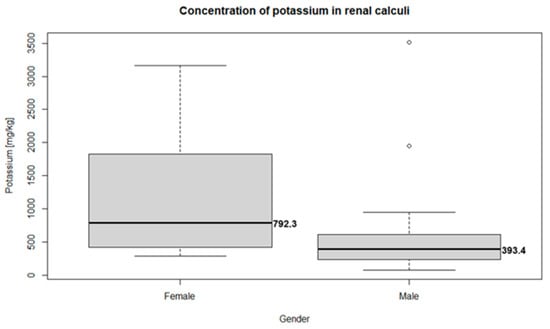
Figure 1
Open AccessCase Report
Fibrillary Glomerulonephritis Diagnosis Is Enhanced by DNAJB9: Three Cases with Different Clinical, Anatomopathologic Features and Outcomes
by
José C. De La Flor, Marco Dominguez Davalos, Tania Linares Grávalos, Marina Alonso-Riaño, Francisco Díaz, Celia Rodríguez Tudero, Rocío Zamora González-Mariño, Michael Cieza Terrones and Jesús Hernández Vaquero
Pathophysiology 2025, 32(2), 22; https://doi.org/10.3390/pathophysiology32020022 - 25 May 2025
Abstract
Background: Fibrillary glomerulonephritis (FGN) is a rare and poorly understood kidney disease characterized by the deposition of non-amyloid fibrils in the glomeruli. Its clinical heterogeneity and high rate of progression to end-stage renal disease (ESRD) pose significant diagnostic and therapeutic challenges. This case
[...] Read more.
Background: Fibrillary glomerulonephritis (FGN) is a rare and poorly understood kidney disease characterized by the deposition of non-amyloid fibrils in the glomeruli. Its clinical heterogeneity and high rate of progression to end-stage renal disease (ESRD) pose significant diagnostic and therapeutic challenges. This case series aims to enhance awareness of FGN and emphasizes the need for further research to improve patient outcomes. Case Reports: We reviewed the clinical, histopathological, and therapeutic data of three patients with FGN diagnosed by kidney biopsy. The cases included variations in clinical presentation from nephrotic syndrome to rapidly progressive glomerulonephritis (RPGN). Diagnostic methods incorporated light microscopy, immunofluorescence, and electron microscopy, with the integration of DnaJ homolog subfamily B member 9 (DNAJB9) staining for confirmation. Patient 1 showed a more favorable response to rituximab, achieving complete remission (CR) at 6 months and maintaining CR after 3 years. Patient 2 showed only partial remission after 2 years following treatment with rituximab. Patient 3 presented with RPGN and rapidly progressed to ESRD despite aggressive immunosuppressive therapy. Discussion: DNAJB9 has emerged as both a specific and sensitive biomarker in patients with FGN and has facilitated accurate differentiation from other glomerulopathies. This series underscores the variability in clinical outcomes and responses to therapy as well as the importance of early and accurate diagnosis. Conclusions: FGN remains a diagnostic and therapeutic challenge due to its rarity and heterogeneity. Advances in biomarkers like DNAJB9 have improved diagnostic accuracy, distinguishing FGN from similar conditions such as immunotactoid glomerulopathy. Further research into pathophysiological mechanisms and targeted therapies is essential to optimize management and outcomes for affected patients.
Full article
(This article belongs to the Section Systemic Pathophysiology)
►▼
Show Figures
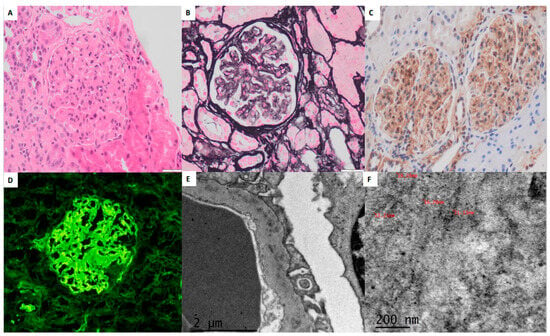
Figure 1
Open AccessArticle
Vitamin D Serum Levels and the Development of Intensive Care Unit-Acquired Weakness: Insights from a COVID-19 Intensive Care Cohort
by
Jelena Gulišija, Vesna Čapkun, Stefan Golic and Sanda Stojanović Stipić
Pathophysiology 2025, 32(2), 21; https://doi.org/10.3390/pathophysiology32020021 - 9 May 2025
Abstract
Background/Objectives: The pathogenesis of intensive care unit-acquired weakness (ICU-AW) is multi-factorial, with some of the main risk factors being sepsis, multiorgan failure, and the inflammatory response related to critical illness. Vitamin D is crucial for muscle function, the immune response, and inflammation,
[...] Read more.
Background/Objectives: The pathogenesis of intensive care unit-acquired weakness (ICU-AW) is multi-factorial, with some of the main risk factors being sepsis, multiorgan failure, and the inflammatory response related to critical illness. Vitamin D is crucial for muscle function, the immune response, and inflammation, and has been identified as a predictor of negative outcomes in intensive care unit (ICU) patients with COVID-19. The objective of this preliminary study was to examine the relationship between vitamin D serum levels and the incidence of ICU-AW in a cohort from the University Hospital of Split. Methods: A prospective observational cohort study was conducted in the University Hospital of Split in ICU from December 2021 to March 2022. The inclusion criteria were as follows: patients over 18 years old who had a confirmed severe acute respiratory coronavirus disease 2 (SARS-CoV-2) infection, patients who were mechanically ventilated for more than 48 h, and patients who were weaned from a ventilator over at least 24 h. The exclusion criteria were a history of neurological or musculoskeletal disorders and a pre-existing poor functional status. Vitamin D was detected in the first routine blood sample. Results: A total of 77 patients were observed, with 36 patients who were successfully weaned from a ventilator over at least 24 h and 1 patient who could not be examined because of impaired consciousness (this patient was excluded from further analysis), and thus a total of 35 patients were analyzed. Of these 35 patients, 12 (34%) developed ICU-AW. The median vitamin D serum level in the ICU-AW group was 17 (7.5–73.3), while that in the non-ICU-AW group was 25.2 (12.3–121). The difference in vitamin D serum levels between the groups was not significantly different from zero (p = 0.567). All patients, except for one, were vitamin D insufficient. Conclusions: Vitamin D serum levels in the ICU-AW group were not statistically different from the non-ICU-AW group, possibly due to the small sample size. Given the known roles of vitamin D in muscle function, immune modulation, and inflammation, a potential etiopathogenetic role in ICU-AW cannot be excluded without additional studies. Therefore, further studies with larger sample sizes than ours are necessary to determine whether vitamin D deficiency contributes to the development of ICU-AW and whether supplementation could have preventive or therapeutic value.
Full article
(This article belongs to the Section Systemic Pathophysiology)
Open AccessCommunication
Resting State of Dementia of the Alzheimer’s Type and Healthy Older Adults Using fNIRS
by
In-sop Kim, Jaejin Hwang, Chorong Oh and Richard J. Morris
Pathophysiology 2025, 32(2), 20; https://doi.org/10.3390/pathophysiology32020020 - 2 May 2025
Abstract
Background/Objectives: This study explores variations in brain activity between individuals with dementia of the Alzheimer’s type (DAT) and healthy older adults during a resting state using functional near-infrared spectroscopy (fNIRS). Methods: FNIRS measured brain activity in ten AD patients and six healthy individuals.
[...] Read more.
Background/Objectives: This study explores variations in brain activity between individuals with dementia of the Alzheimer’s type (DAT) and healthy older adults during a resting state using functional near-infrared spectroscopy (fNIRS). Methods: FNIRS measured brain activity in ten AD patients and six healthy individuals. A device with 16 channels was placed on each participant’s forehead to measure oxygenation levels while they kept their eyes closed. The data were analyzed using a support vector machine (SVM) model. Results: The results indicated differences in oxygenated hemoglobin (HbO) levels between the two groups. Specifically, HbO levels were generally higher in the dementia group in the left hemisphere, with a sharp increase after 26 s. Conversely, HbO levels were consistently lower in the right hemisphere of the dementia group. The SVM analysis demonstrated high accuracy in differentiating between the AD and healthy groups based on HbO levels. Conclusions: The study indicates that differences in brain activity during resting state can potentially distinguish people with DAT from healthy individuals. We found relatively reduced hemoglobin activity in the prefrontal areas of those with DAT. Furthermore, the concentration changes in the HbO in the left lateral prefrontal and right medial brain regions emerged as the most informative in distinguishing individuals with DAT from healthy individuals. The results of the current study show that this method could improve current DAT diagnostic practices due to its efficiency.
Full article
(This article belongs to the Special Issue New Insights into Diseases with Cognitive Impairment: Development, Genesis, and Treatment)
►▼
Show Figures

Figure 1
Open AccessArticle
Therapeutic Efficacy of Mesenchymal Stem Cells in Modulating Oxidative Stress in Puromycin-Induced Nephropathy
by
Yusuke Iizuka, Masanori Sasaki, Kojiro Terada, Takuro Sakai, Yoshinobu Nagaoka, Shinobu Fukumura, Jeffery D. Kocsis, Takeshi Tsugawa and Osamu Honmou
Pathophysiology 2025, 32(2), 19; https://doi.org/10.3390/pathophysiology32020019 - 1 May 2025
Abstract
Background: Podocytes are essential for kidney function, and their dysfunction can result in nephrotic syndrome, such as minimal change disease (MCD). Oxidative stress contributes to podocyte damage. We investigated the therapeutic potential of intravenously infused mesenchymal stem cells (MSCs) in a puromycin aminonucleoside
[...] Read more.
Background: Podocytes are essential for kidney function, and their dysfunction can result in nephrotic syndrome, such as minimal change disease (MCD). Oxidative stress contributes to podocyte damage. We investigated the therapeutic potential of intravenously infused mesenchymal stem cells (MSCs) in a puromycin aminonucleoside (PAN)-induced rodent MCD model, focusing on oxidative stress modulation. Methods: Sprague-Dawley rats were divided into three groups: intact, PAN-Vehicle, and PAN-MSC. MCD was induced through subcutaneous PAN injection. MSCs were infused intravenously in the PAN-MSC group on day 7. Urinary albumin, serum albumin, and creatinine levels were assessed. Histological analysis of the renal cortex was performed. Podocyte protein (NPHS1, NPHS2, and PODXL) and antioxidant enzyme (SOD1, SOD2, and GPX1) levels were measured using quantitative real-time reverse-transcription PCR (qRT-PCR). Results: MSC infusion significantly reduced proteinuria and restored podocyte structure in the PAN-MSC group. Electron microscopy revealed that infused MSCs could inhibit the fusion of the foot process induced by PAN injection. qRT-PCR showed that intravenous infusion of MSCs rescued the inhibition of GPX1 expression. GFP-labeled MSCs accumulated at the podocyte injury sites. Conclusion: Systemic MSC infusion mitigates PAN-induced MCD by reducing proteinuria, preserving podocyte structure, and modulating oxidative stress via the GPX1 pathway, offering a potential therapeutic approach for nephrotic syndrome.
Full article
(This article belongs to the Section Cellular and Molecular Mechanisms)
►▼
Show Figures

Figure 1
Open AccessArticle
The Pathophysiological Mechanisms and Pattern of Dyslipidemia Associated with Iodine Deficiency and Subclinical Hypothyroidism in Pregnant Normotensive and Preeclamptic Central African Women
by
Charles Bitamazire Businge and Benjamin Longo-Mbenza
Pathophysiology 2025, 32(2), 18; https://doi.org/10.3390/pathophysiology32020018 - 18 Apr 2025
Abstract
Background: Pregnancy simulates a metabolic syndrome-like state and predisposes to iodine deficiency and hypothyroidism through increased iodine renal loss and transplacental transfer to the fetus. Iodine deficiency is thought to predispose to dyslipidemia through elevation of serum TSH. Obesity, dyslipidemia, and hypothyroidism are
[...] Read more.
Background: Pregnancy simulates a metabolic syndrome-like state and predisposes to iodine deficiency and hypothyroidism through increased iodine renal loss and transplacental transfer to the fetus. Iodine deficiency is thought to predispose to dyslipidemia through elevation of serum TSH. Obesity, dyslipidemia, and hypothyroidism are established risk factors of preeclampsia. Hence, pregnant women with iodine deficiency are likely to be at increased risk of dyslipidemia and preeclampsia. We investigated the pattern of dyslipidemia among preeclamptic and normotensive pregnant women with and without iodine deficiency. Methods: The pathophysiological mechanisms linking iodine deficiency and dyslipidemia were delineated using bivariate correlations, logistic regression, and exploratory factor analysis of anthropometric, lipid profile, urine iodine concentration (UIC), and thyroid function data from 240 women with preeclampsia and 120 normotensive pregnant controls at term who attended Lomo Medical Centre, Democratic Republic of Congo (DRC). Results: Preeclamptic women with iodine deficiency had significantly lower HDL-C but higher triglyceride levels than those with sufficient iodine intake. Both normotensive and preeclamptic participants with elevated TSH had high serum oxidized LDL-C but low NO, p < 0.001. Conclusions: SCH, secondary to iodine deficiency, is associated with elevated serum oxidized LDL and decreased Nitric Oxide (NO) among both normotensive and preeclamptic women, while insufficient iodine nutrition among preeclamptic women predisposes to reduced HDL-C and increased serum Triglycerides, which are risk factors of atherosclerosis and cardiovascular disease.
Full article
(This article belongs to the Section Metabolic Disorders)
►▼
Show Figures

Figure 1
Open AccessReview
Immunological Disorders: Gradations and the Current Approach in Laboratory Diagnostics
by
Anna A. Starshinova, Andrey An. Savchenko, Alexander Borisov, Igor Kudryavtsev, Artem Rubinstein, Irina Dovgalyuk, Anastasia Kulpina, Leonid P. Churilov, Polina Sobolevskaia, Tamara Fedotkina, Dmitry Kudlay and Evgeny V. Shlyakhto
Pathophysiology 2025, 32(2), 17; https://doi.org/10.3390/pathophysiology32020017 - 18 Apr 2025
Abstract
Currently, understanding the immune response, its abnormalities, and its diagnostic possibilities is a key point in the management of patients with various diseases, from infectious to oncological ones. The aim of this review was to analyze the data presented in the current literature
[...] Read more.
Currently, understanding the immune response, its abnormalities, and its diagnostic possibilities is a key point in the management of patients with various diseases, from infectious to oncological ones. The aim of this review was to analyze the data presented in the current literature on immune disorders and the possibility of their laboratory diagnostics in combination with clinical manifestations. We have performed a systematic analysis of the literature presented in international databases over the last ten years. We have presented data on the possibility of diagnosing immunopathological processes due to changes in immune cells and soluble molecules involved in the pathogenesis of a wide range of diseases, as well as the determination of antibodies to detect autoimmune processes. By applying laboratory techniques such as hematology, flow cytometry, ELISA, etc., available to most clinical laboratories worldwide, clinical data on immune system dysfunction in a wide range of diseases are being collected. This process is unfortunately still very far from being completed. However, with all the diversity of accumulated knowledge, we can currently state that the pathogenesis of the vast majority of immune-mediated diseases is not yet known. At the same time, the current success in dividing immune-mediated diseases into distinct clusters based on different types of inflammatory responses that are based on the involvement of different populations of T helper cells and cytokine molecules represents significant progress. Further research in this direction seems very promising, as it allows the identification of new target cells and target molecules for both improved diagnostics and targeted therapies.
Full article
(This article belongs to the Topic Individualized Molecular Mechanisms and Treatment in Tumor Metastasis)
►▼
Show Figures

Figure 1
Highly Accessed Articles
Latest Books
E-Mail Alert
News
Topics
Topic in
Clinics and Practice, JCM, Therapeutics, Diseases, Pathophysiology
Acute Respiratory Distress Syndrome (ARDS): Personalized Therapies and Beyond, 2nd Edition
Topic Editors: Denise Battaglini, Patricia Rieken Macêdo RoccoDeadline: 31 December 2025
Topic in
Cells, Organoids, Cancers, Metabolites, Pathophysiology
Overview of Cancer Metabolism
Topic Editors: Arnaud Blomme, Cyril CorbetDeadline: 31 March 2026

Conferences
Special Issues
Special Issue in
Pathophysiology
Biomedical Engineering Applied to Pathophysiological Processes
Guest Editors: Giovanni F. Solitro, Vladimir ReukovDeadline: 31 December 2025
Special Issue in
Pathophysiology
Obstructive Sleep Apnea Phenotypes: First Decade of Exploration and Beyond
Guest Editors: Jonathan Steven Alexander, Oleg ChernyshevDeadline: 31 December 2025
Special Issue in
Pathophysiology
Feature Articles in Cardiovascular Pathophysiology
Guest Editors: Jonathan Steven Alexander, Rodney Edwin ShackelfordDeadline: 31 December 2025
Topical Collections
Topical Collection in
Pathophysiology
Feature Papers in Pathophysiology
Collection Editor: Jonathan Steven Alexander






